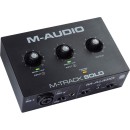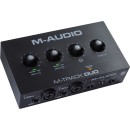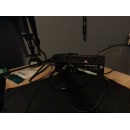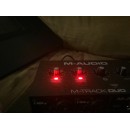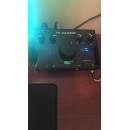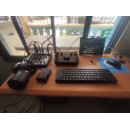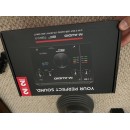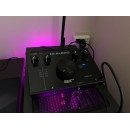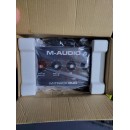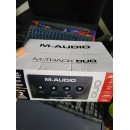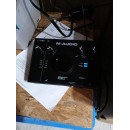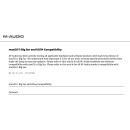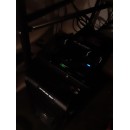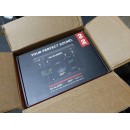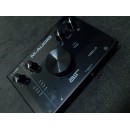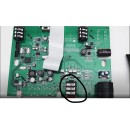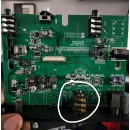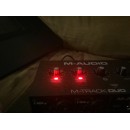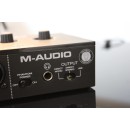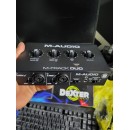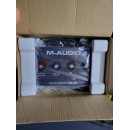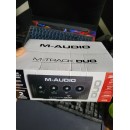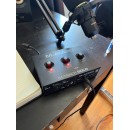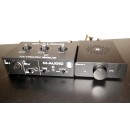M-Audio M-Track Solo vs. M-Track Duo: In-Depth Comparison
The M-Audio M-Track Duo is a compact and versatile 2-channel USB audio interface. It features two combo XLR/TRS inputs, allowing for both microphone and line-level instrument inputs. The interface supports 48 kHz/24-bit resolution, ensuring high-quality audio recordings. It also includes +48V phantom power, making it compatible with condenser microphones. The M-Track Duo is equipped with zero-latency monitoring, thanks to its direct monitor switch, which lets users hear their input signals in real time without any delay. This interface is ideal for musicians and podcasters who need a reliable and straightforward device for capturing vocals and instruments.
On the other hand, the M-Audio M-Track Solo Desktop 2x2 USB Audio Interface shares many similarities with the M-Track Duo but is slightly more tailored for solo performers and podcasters. It features one combo XLR/TRS input and one dedicated instrument input, which is perfect for single users who are recording vocals and an instrument simultaneously. Like the Duo, it supports a 48 kHz/24-bit resolution and provides +48V phantom power. The M-Track Solo also includes a direct monitoring feature to ensure zero-latency tracking. Despite having fewer input options than the Duo, the M-Track Solo is compact and highly portable, making it an excellent choice for solo artists and content creators on the go.
Both interfaces are USB-powered, eliminating the need for an external power supply, and are compatible with most DAWs on both Windows and Mac operating systems. They come bundled with a software suite that includes DAWs and virtual instruments, providing users with everything they need to start recording right out of the box.
In summary, the M-Audio M-Track Duo is suited for users who require two versatile inputs for more complex recording setups, while the M-Audio M-Track Solo is optimized for solo performers needing a straightforward and portable recording solution. Both models deliver high-quality audio and essential features, making them valuable tools for any budding audio enthusiast.
Detailed Specifications and Review of M-Audio M-Track Solo and M-Track Duo
| User Rating Based on Analysis of Reviews | |
|---|---|
|
Show More |
| Pros: | |
|---|---|
|
|
| Cons: | |
|---|---|
|
|
| Find Best Price | Find Best Price |
| Key Specs | |
|---|---|
| Channels of I/O | |
| Analog: 2 Inputs / 2 Outputs |
Analog: 2 Inputs / 2 Outputs at 192 kHz |
| Maximum Sampling Rate | |
| 48 kHz / 16-Bit | 48 kHz / 24-Bit |
| Number of Microphone Inputs | |
| 1 Preamp | 2 Preamps |
| Analog Audio I/O | |
| 1x Combo XLR-1/4" TRS Balanced Mic/Line Input (Front Panel) 1x 1/4" TRS Balanced/Unbalanced Line/Hi-Z Input (Front Panel) 1x Stereo RCA Coaxial Unbalanced Monitor Output 1x 1/8" / 3.5 mm TRS Unbalanced Headphone Output (Front Panel) |
2x Combo XLR-1/4" TRS Balanced/Unbalanced Mic/Line/Hi-Z Input (Front Panel) 2x 1/4" TRS Balanced Line Output 1x 1/4" TRS Unbalanced Headphone Output (Front Panel) |
| Host Connection | |
| 1x USB-B (Class-Compliant) | 1x USB-B (Class-Compliant) |
| OS Compatibility | |
| macOS 10.8 or Later Windows 7 or Later (32-/64-Bit) |
macOS 10.8 or Later Windows 7 or Later (32-/64-Bit) |
| Power Requirements | |
| USB Bus Power | USB Bus Power |
The M-Audio M-Track Duo offers a higher maximum sampling rate of 48 kHz at 24-Bit compared to the M-Track Solo's 48 kHz at 16-Bit. This higher bit depth in the Duo provides more detailed audio resolution, which can be beneficial for professional recording applications. In terms of input/output channels, both interfaces offer 2 analog inputs and 2 outputs. However, the Duo features two combo XLR-1/4" TRS inputs on the front panel, allowing for more flexibility in connecting microphones and line instruments simultaneously. In contrast, the Solo provides one combo XLR-1/4" TRS input and an additional 1/4" TRS input, which limits the number of microphones that can be connected at the same time to one.
The Duo's analog audio I/O also includes two 1/4" TRS balanced line outputs and a 1/4" TRS unbalanced headphone output, whereas the Solo offers stereo RCA coaxial unbalanced monitor outputs and a 1/8" (3.5mm) TRS unbalanced headphone output. This difference in output options may influence user decisions based on the type of monitoring and speaker systems they use, with the Duo being more suitable for professional studio monitors that commonly use balanced TRS connections.
Both interfaces are USB class-compliant and are compatible with macOS 10.8 or later and Windows 7 or later (32-/64-Bit). They are powered via USB bus power, making them portable and easy to use with a single USB connection to a computer. The host connection for both devices uses a USB-B port.
In summary, while both the M-Track Duo and the M-Track Solo are designed for similar purposes, the Duo offers higher bit-depth recording, more flexible input options with dual combo XLR-1/4" TRS inputs, and balanced TRS outputs, making it a more versatile choice for users requiring higher audio fidelity and more robust connectivity options. The Solo, with its simpler input configuration, may be more suitable for users with basic recording needs or those using it primarily for podcasting or streaming with fewer input requirements.
| General | |
|---|---|
| Channels of I/O | |
| Analog: 2 Inputs / 2 Outputs |
Analog: 2 Inputs / 2 Outputs at 192 kHz |
| Maximum Sampling Rate | |
| 48 kHz / 16-Bit | 48 kHz / 24-Bit |
| Number of Microphone Inputs | |
| 1 Preamp | 2 Preamps |
| Input Level Adjustment | |
| 2x Knob | 2x Knob |
| Expansion Slots | |
Firstly, in terms of channels of I/O, both interfaces provide analog 2 inputs and 2 outputs. However, while the M-Track Duo supports a maximum sampling rate of 48 kHz at 24-bit, the M-Track Solo supports a maximum sampling rate of 48 kHz at 16-bit. This indicates that the M-Track Duo offers higher bit depth, which can result in more detailed audio capture.
The number of microphone inputs is another significant difference. The M-Track Duo is equipped with 2 preamps, allowing for two simultaneous microphone inputs, whereas the M-Track Solo only has 1 preamp, accommodating just one microphone input. This makes the M-Track Duo more suitable for situations requiring multiple microphone recordings, such as duets or interviews.
Both interfaces feature input level adjustment through two knobs, providing users with straightforward control over their input levels. Neither the M-Track Duo nor the M-Track Solo includes expansion slots or a built-in microphone, which keeps their designs simple and focused on essential functionalities.
In summary, while both the M-Track Duo and M-Track Solo offer similar I/O channel configurations and input level adjustments, the M-Track Duo stands out with its higher bit depth and additional microphone input. The M-Track Solo, on the other hand, may be more suited for solo recording needs with its single microphone preamp.
| Signal Processing | |
|---|---|
| Pad | |
| Gain/Trim Range | |
| Mic Inputs: 0 to +54 dB Line/Hi-Z Inputs: -10 to +44 dB |
Mic Inputs: Up to +60 dB Line/Hi-Z Inputs: Up to +50 dB |
| High-Pass Filter | |
| Solo/Mute | |
The M-Audio M-Track Duo offers a more extensive gain/trim range for both microphone and line/Hi-Z inputs. Specifically, its mic inputs can provide up to +60 dB of gain, and its line/Hi-Z inputs can deliver up to +50 dB of gain. This makes the Duo more suitable for a wider variety of microphones and instruments, especially those that may require higher gain settings.
In contrast, the M-Audio M-Track Solo provides a more limited gain/trim range. Its mic inputs range from 0 to +54 dB, and its line/Hi-Z inputs range from -10 to +44 dB. While this is sufficient for many basic recording needs, it may not offer enough gain for some low-output microphones or instruments, thereby limiting its versatility compared to the Duo.
Both interfaces lack additional features such as a pad, high-pass filter, and solo/mute options, focusing instead on providing essential functionality for straightforward recording tasks. This makes them both suitable for beginners or those who need a simple, easy-to-use interface.
Overall, if you require a wider gain/trim range for better compatibility with a variety of audio sources, the M-Track Duo is the more robust option. On the other hand, the M-Track Solo may suffice for users with less demanding gain requirements.
| Connectivity | |
|---|---|
| Analog Audio I/O | |
| 1x Combo XLR-1/4" TRS Balanced Mic/Line Input (Front Panel) 1x 1/4" TRS Balanced/Unbalanced Line/Hi-Z Input (Front Panel) 1x Stereo RCA Coaxial Unbalanced Monitor Output 1x 1/8" / 3.5 mm TRS Unbalanced Headphone Output (Front Panel) |
2x Combo XLR-1/4" TRS Balanced/Unbalanced Mic/Line/Hi-Z Input (Front Panel) 2x 1/4" TRS Balanced Line Output 1x 1/4" TRS Unbalanced Headphone Output (Front Panel) |
| Phantom Power | |
| 48 V, Selectable On/Off | 48 V, Selectable On/Off (Applied to All Inputs) |
| Digital Audio I/O | |
| Host Connection | |
| 1x USB-B (Class-Compliant) | 1x USB-B (Class-Compliant) |
| Host Connection Protocol | |
| USB 2.0 | USB 2.0 |
| USB (Non-Host) | |
| Sync I/O | |
| Network I/O | |
| MIDI I/O | |
In terms of analog audio inputs and outputs, the M-Track Duo provides 2 combo XLR-1/4" TRS balanced/unbalanced mic/line/Hi-Z inputs on the front panel, making it versatile for different types of connections. It also includes 2x 1/4" TRS balanced line outputs and a 1/4" TRS unbalanced headphone output on the front panel. On the other hand, the M-Track Solo offers a single combo XLR-1/4" TRS balanced mic/line input and an additional 1/4" TRS balanced/unbalanced line/Hi-Z input on the front panel. The Solo also provides a stereo RCA coaxial unbalanced monitor output and a 1/8" (3.5 mm) TRS unbalanced headphone output on the front panel, which might be more convenient for users with smaller headphones.
Both interfaces feature 48V selectable phantom power, which is essential for powering condenser microphones. This phantom power is applied to all inputs on both devices, ensuring compatibility with a wide array of microphones.
Regarding digital audio inputs and outputs, neither the M-Track Duo nor the M-Track Solo includes any digital I/O options. They both rely solely on analog connections for audio input and output.
For host connection, both interfaces use a single USB-B port and are class-compliant, meaning they can be easily connected to a computer without requiring additional drivers. They both operate using the USB 2.0 protocol, ensuring compatibility with most modern computers.
Neither the M-Track Duo nor the M-Track Solo offers additional USB (non-host) connections, sync I/O, network I/O, or MIDI I/O. This makes them straightforward devices focused primarily on audio recording without added complexity or features for digital synchronization or networked audio.
In summary, the M-Track Duo is more versatile in terms of analog inputs and outputs, making it a better choice for users needing multiple mic/line inputs and balanced outputs. The M-Track Solo, however, provides a more compact and straightforward solution with its RCA monitor outputs and smaller headphone jack, which may be preferred for simpler setups or users with limited space.
| Performance | |
|---|---|
| Frequency Response | |
| Mic, Line, Hi-Z Inputs: 20 Hz to 20 kHz ±0.1 dB Monitor Outputs: 20 Hz to 20 kHz ±0.1 dB Headphone Outputs: 20 Hz to 20 kHz ±0.5 dB |
Mic, Line, Hi-Z Inputs: 20 Hz to 20 kHz +0.1 dB Monitor Outputs: 20 Hz to 20 kHz +0.1 dB Headphone Outputs: 20 Hz to 20 kHz +0.5 dB |
| Maximum Output Level | |
| Line Outputs: +4 dBu |
Line Outputs: +4 dBu |
| Headphone Output Power | |
| 60 mW per Channel into 32 Ohms | 60 mW per Channel into 32 Ohms |
| Impedance | |
| Hi-Z Inputs: 1 Megohm (Unbalanced) |
Hi-Z Inputs: 1 Megohm (Unbalanced) |
| SNR | |
| Mic Inputs: 109 dB (A-Weighted) Monitor Outputs: 109 dB (A-Weighted) Headphone Outputs: 100 dB (A-Weighted) |
Mic Inputs: 109 dB (A-Weighted) Monitor Outputs: 109 dB (A-Weighted) Headphone Outputs: 100 dB (A-Weighted) |
| THD+N | |
| Mic Inputs: 0.003% (A-Weighted, Min Gain, at 0 dBu) Line Inputs: 0.002% (A-Weighted, Min Gain, at 0 dBu) Hi-Z Inputs: 0.005% (A-Weighted, Min Gain, at 0 dBu) Monitor Outputs: 0.002% (A-Weighted, at 0 dBu) Headphone Outputs: 0.02% (A-Weighted) |
Mic Inputs: 0.003% (A-Weighted, Min Gain, at 0 dBu) Hi-Z Inputs: 0.005% (A-Weighted, Min Gain, at 0 dBu) Headphone Outputs: 0.02% (A-Weighted) |
| EIN | |
| Mic Inputs: -128 dBu A-Weighted (Max Gain) |
Mic Inputs: -128 dBu A-Weighted (Max Gain) |
In terms of frequency response, both interfaces offer an identical range for Mic, Line, and Hi-Z inputs at 20 Hz to 20 kHz with a precision of ±0.1 dB for monitor outputs and ±0.5 dB for headphone outputs. This ensures accurate audio reproduction across the audible spectrum for both devices.
When it comes to maximum output level, both interfaces provide a line output of +4 dBu, and the headphone output power is also the same at 60 mW per channel into 32 Ohms. This consistency in output levels ensures that both interfaces deliver robust and clear audio signals suitable for professional monitoring and playback environments.
The impedance for Hi-Z inputs on both interfaces stands at 1 Megohm (Unbalanced), ensuring that they both can handle high-impedance instruments like electric guitars and basses effectively.
Signal-to-noise ratio (SNR) is another area where both interfaces perform equally well. Both the M-Track Duo and the M-Track Solo offer an SNR of 109 dB (A-Weighted) for mic inputs and monitor outputs, and 100 dB (A-Weighted) for headphone outputs. This high SNR ensures minimal background noise, providing clean and clear audio recordings.
The Total Harmonic Distortion (THD) and Total Harmonic Distortion plus Noise (THD+N) measurements for both interfaces are also quite similar. Both have a THD of 0.002% for line inputs and monitor outputs at 0 dBu. The THD+N values are also consistent with 0.003% for mic inputs, 0.005% for Hi-Z inputs, and 0.02% for headphone outputs (all A-Weighted). These low distortion figures indicate that both interfaces are capable of reproducing audio with high fidelity and minimal coloration.
Lastly, both the M-Track Duo and the M-Track Solo feature an Equivalent Input Noise (EIN) of -128 dBu (A-Weighted) at maximum gain for mic inputs, which ensures exceptionally low self-noise, making them suitable for recording quiet sources without introducing significant noise.
In conclusion, the M-Audio M-Track Duo and the M-Track Solo are nearly identical in terms of their technical specifications, offering high-quality audio performance with minimal noise and distortion. Choosing between them may come down to other factors such as physical design, connectivity options, or personal preference.
| Digital Audio | |
|---|---|
| Sample Rates | |
| 48 kHz (AD/DA Conversion) | 48 kHz (AD/DA Conversion) |
| Sample Rate Conversion | |
| Bit Depths | |
| 16-Bit (AD/DA Conversion) | 24-Bit (AD/DA Conversion) |
| Latency | |
| Zero-Latency Direct Monitoring | Zero-Latency Direct Monitoring |
| Sync Sources | |
| Internal | Internal |
Both interfaces support a sample rate of 48 kHz for AD/DA conversion, ensuring they can handle professional audio recording and playback. Neither of the devices supports sample rate conversion, so they both work solely at the 48 kHz rate. This uniformity makes them suitable for users who need consistency in their recording setups without necessitating additional sample rate conversion processes.
Zero-latency direct monitoring is a feature present in both interfaces, allowing for real-time monitoring of input signals without the delay that can interfere with performance and recording quality. This feature is crucial for musicians and producers who require immediate feedback to ensure accuracy and synchronization during their recording sessions. Additionally, both interfaces use internal sync sources, simplifying their operation by not requiring external synchronization devices.
The primary distinction between the two lies in their bit depth capabilities. The M-Audio M-Track Duo supports a 24-bit depth for AD/DA conversion, which provides higher resolution and more detailed audio recordings. In contrast, the M-Audio M-Track Solo offers a 16-bit depth, which, while still adequate for many recording purposes, does not capture the same level of detail and dynamic range as the 24-bit depth. Thus, the M-Track Duo is better suited for professional or more demanding audio production environments where capturing the finest nuances of sound is essential.
In summary, the M-Audio M-Track Duo USB-B Audio Interface and the M-Audio M-Track Solo Desktop 2x2 USB Audio Interface are similar in their sample rate, latency, and sync source features. However, the M-Track Duo stands out with its 24-bit depth capability, offering superior audio resolution compared to the 16-bit depth of the M-Track Solo. This difference makes the Duo a more suitable choice for users who require higher quality and more detailed audio recordings.
| Audio Storage & Playback | |
|---|---|
| Memory Card Slot | |
The M-Audio M-Track Duo and the M-Track Solo share this characteristic, making them equally suitable for users who do not require an integrated memory card slot for their recording setup. Both interfaces are designed to connect via USB to a computer, where the recorded audio can be stored and processed. This commonality in the absence of a memory card slot highlights their focus on simplicity and direct-to-computer recording workflows.
In summary, the M-Audio M-Track Duo and the M-Track Solo both lack a memory card slot, necessitating the use of a computer for audio file storage. This shared feature aligns with their intended use cases and ensures that users will need to manage their recordings through connected computer systems.
| Compatibility | |
|---|---|
| OS Compatibility | |
| macOS 10.8 or Later Windows 7 or Later (32-/64-Bit) |
macOS 10.8 or Later Windows 7 or Later (32-/64-Bit) |
| Required Hardware | |
| Available USB-A Port USB Cable (Included) |
Available USB-A Port USB Cable (Included) |
| Internet Connection | |
| Required for Registration, Software/Driver Download | Required for Registration, Software/Driver Download |
Both the M-Track Duo and the M-Track Solo are compatible with macOS 10.8 or later and Windows 7 or later (32-/64-bit), ensuring they can operate smoothly on a wide range of modern computer systems. This compatibility is crucial for users who may be working across different platforms or updating their operating systems.
In terms of required hardware, both interfaces necessitate an available USB-A port and include a USB cable in the package. This ensures that users can easily connect the interfaces to their computers without needing to purchase additional cables or adapters.
Finally, both devices require an internet connection for registration and for downloading necessary software or drivers. This requirement ensures that users have access to the latest updates and support from M-Audio, enhancing the overall user experience and functionality of the audio interfaces.
Overall, the M-Audio M-Track Duo and M-Track Solo offer similar support in terms of OS compatibility, required hardware, and internet connection needs, making them both accessible and user-friendly options for audio recording and production.
| Power | |
|---|---|
| Power Requirements | |
| USB Bus Power | USB Bus Power |
In terms of practical application, the USB bus power feature ensures that both the M-Track Duo and the M-Track Solo can be swiftly and effortlessly connected to a computer, reducing cable clutter and simplifying the user experience. This is particularly advantageous for users who require quick setup times and minimal technical complications, whether they are recording at home or on the go.
Overall, the shared power requirement of USB bus power in both the M-Audio M-Track Duo and M-Track Solo underscores their design philosophy of offering user-friendly, efficient, and portable audio recording solutions. This feature makes them suitable for a wide range of recording scenarios, from home studios to mobile recording sessions.
| Physical | |
|---|---|
| Dimensions | |
| 6.4 x 4.5 x 2.1" / 16.3 x 11.4 x 5.3 cm | 7.5 x 4.4 x 2.1" / 19.1 x 11.2 x 5.3 cm |
| Weight | |
| 0.7 lb / 0.3 kg | 0.8 lb / 0.4 kg |
The M-Audio M-Track Duo USB-B Audio Interface measures 7.5 x 4.4 x 2.1 inches (19.1 x 11.2 x 5.3 cm) and weighs approximately 0.8 lb (0.4 kg). On the other hand, the M-Audio M-Track Solo Desktop 2x2 USB Audio Interface is slightly more compact, with dimensions of 6.4 x 4.5 x 2.1 inches (16.3 x 11.4 x 5.3 cm) and a lighter weight of about 0.7 lb (0.3 kg).
In essence, the M-Track Solo is more portable due to its smaller size and lighter weight, which could be an advantage for users who need a highly mobile audio interface solution. Meanwhile, the M-Track Duo, being marginally larger and heavier, might offer more stability when placed on a desktop, but still remains relatively easy to transport and handle.
| Packaging Info | |
|---|---|
| Package Weight | |
| 1.155 lb | 1.32 lb |
| Box Dimensions (LxWxH) | |
| 8 x 6 x 3.7" | 9 x 6.1 x 3.7" |
The M-Audio M-Track Duo USB-B Audio Interface comes with a package weight of 1.32 lb and has box dimensions measuring 9 x 6.1 x 3.7 inches. This suggests that the M-Track Duo is slightly heavier and marginally larger in terms of packaging compared to the M-Track Solo.
On the other hand, the M-Audio M-Track Solo Desktop 2x2 USB Audio Interface has a package weight of 1.155 lb and box dimensions of 8 x 6 x 3.7 inches. This makes the M-Track Solo lighter and a bit more compact than the M-Track Duo, which may be advantageous for users with limited space or those who require greater portability.
In summary, while both audio interfaces are relatively lightweight and compact, the M-Track Solo is the lighter and more compact option, whereas the M-Track Duo is slightly heavier and larger.
| Customer Images | |
|---|---|
